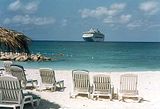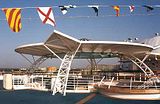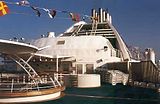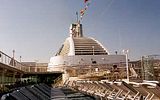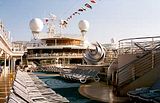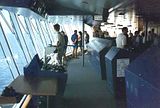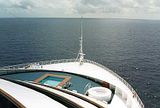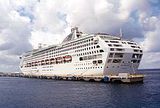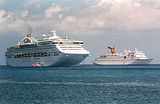Blood Pressure Woes
In the following scenario, two diseases are exposed, both are silent in progression in early stages, and both can cause insult to the body's homeostasis. In George's case, he has been battling with partially controlled hypertension for the past five years. What he did not realized that his partially controlled hypertension was not preventing damage to his kidneys.
George is a 55 y.o. male who has had hypertension (HTN) for the last 5 years. His HTN is only partially controlled. He is trying to watch his diet, but does not exercise like he should due to his high-stress job. He is also on HTN medication. He monitors his blood pressure at home on a regular basis. For the past month he has noticed his blood pressure seems to be higher than usual and even harder to control, but figured it was due to the stress of a big project at work. In the past 2 weeks, however, he has noticed he does not feel like eating much; he is fatigued; he seems to be urinating more often; and he has been losing weight. He decides to go in to see the doctor.
Total peripheral blood flow should be equal to cardiac output. Adequate blood pressure (B/P) is needed to overcome friction and elastic forces and to maintain blood flow. If blood pressure is too low, vessels collapse; likewise, if blood pressure is too high, vessels stiffen. A normal B/P is <120 140="" and="" arterial="" b="" cardiac="" contraction="" diastolic="" high="" hypertension="" minimum="" peak="" phase="" pressure="" relaxation="" systolic="">) is when high pressure (tension / vasoconstriction / increase peripheral resistance) is created in the arteries. Pressure and resistance can effect blood flow. When pressure increases, blood flow increases, however, if vascular resistance increases, systemic blood flow decreases. The variance causes the heart to produce enough pressure to compensate for any resistance in order to maintain adequate blood flow. Chronic hypertension can cause complications in the cardiovascular system. According to the National Kidney Foundation, hypertension is the leading cause of heart attacks, strokes, and chronic kidney disease. p.308-311
George's doctor decides to run several tests with the following results: Blood Test Results: RBC: 3.8 million cells/mcL; WBC: 10,000 cells/mcL; Hgb: 11.0 gm/ dL. Urine Test Results: GFR: 45ml/min/1.73m; Creatinine: 3g/ 24hr; Protein: 3g/ 24hr. The diagnosis George received was Chronic Renal Failure.
The kidneys are the body's primary excretory organ along with the skin and respiratory systems. It regulates the internal environment of the body by selectively excreting foreign material (drugs, toxins etc.) and metabolic waste while retaining valuable water, organic nutrients, and electrolytes in order to maintain adequate blood volume and composition. Urine is the end product of metabolism. Urine formation begins in the glomerular capillaries and ends in the collecting ducts ranging between dilute to concentrate composition (pH 4.5 – 8), depending on the body's physiological needs. Handy Tables, (Gould, B. E. , pg 440, 444-445, 2011)
Each kidney consist approximately one million of nephrons. The nephron is the basic functional unit in the kidney. The nephron consist of a renal corpuscle (filtering system known as a glomerulus )and a tubule. The glomerulus (site of filtration) is composed of a capillary network surrounded by a round structure called Bowman's capsule. Between twenty and twenty-five percent of cardiac output per minute flows into the renal artery. The route of blood flow into the kidney starts at the renal artery then proceeds into interlobar artery, then arches into arcuate artery, then flows into interlobar artery, meeting its final destination in the afferent arteriole which is the entrance into the glomerulus At the distal end of the glomerus, the capillaries rejoin to form the efferent arteriole through which blood eventually winds itself back to the renal vein. The dual arterioles controls the pressure (passive) in the glomerular capillaries and the glomerular filtration pressure. The glomerular capillaries restrict only large molecules (protein) resulting into filtrate that consist of plasma minus the large molecules. (Gould, B. E., pg 440- 442, 2011)
Filtrates leaves the glomerulus and enters the renal tubule which reabsorbs all useful organic molecules from the filtrate, reabsorbs > 90% water (osmotic), and secretes into the tubular fluid any waste products that were missed by the filtration process. In the collecting duct, additional reabsorption of water and absorption or active secretion of sodium, potassium, hydrogen, and bicarbonate ions before urine is released. Both secretion and absorption are controlled by selective permeability in different areas of the renal tubule and the response of hormones such as aldosterone ( responds to low sodium or high potassium concentrate), antidiuretic hormone ( >ADH >water permeability making urine more concentrated), and kidney hormones calcitriol, erythropoiten, and renin. (Gould, B. E., pg.440-443, 2011)
As previously mentioned, one of the kidney's main function is to regulate blood volume and blood pressure. Renin an enzyme/ hormone is release in response to low glomerular pressure due to declining blood volume ( low salt and water retention), declining blood pressure or both and triggers the renin-angiotensin system ( leads to formation of angiotensin II). The response triggers the sympathetic nervous system (SNS) to cause a notable peripheral vasoconstriction of the capillaries, elevating B/P in the renal arteries. It also causes constriction of the efferent arterioles, elevating glomerular pressure and filtration rates. In turn the release of ADH promotes water and sodium absorption, increasing the thirst feeling. To maintain homeostasis, a hormone called atrial natriuretic peptide ( released by the atrial cardiac muscle cells), becomes involved to reverse high blood volume and blood pressure leading to an increase sodium excreted in the urine and inhibits renin. (Gould, B. E., pg.442, 2011)
Two other hormones release by the kidneys are calcitriol and erythropoitin. Calcitriol is an hormone released by the kidneys in order to stimulate absorption of calcium and phosphate in the small intestine.
Calcitriol is a converted form of vitamin D3 that has been absorbed from sun light into the skin, modified and released from the liver and converted in the kidneys. It is use to promote bone health.
Erythropoiten is a hormone release by the kidneys when there is low oxygen levels in the kidney tissue. Erythropoitin stimulates the bone marrow to produce more red blood cells, increasing the blood volume and improves oxygen delivery to the tissues. (Gould, B. E., pg .244, 2011) (medicinenet, 2012)
When kidney function becomes comprised by hypertension, as in George's case, the process of glomerular filtration and renal tubular absorption and secretion become affected. Chronic renal failure is where the kidney function deteriorates gradually. The condition can not be reversed, only prolonged, and symptoms of acute renal failure can eventually developed because of scar tissue and loss of functional organization. George initially may not have known he had his chronic kidney failure since gradual loss of nephrons usually occurs without symptoms until it becomes well advanced. The kidneys are highly adaptable and are able to compensate for loss function with the surviving nephrons. In George's case, hypertension may have cause of the chronic renal failure. George's labile B/P status in the past month may have resulted from the progression of his chronic kidney disease, thereby , creating an inadequate blood flow into the glomeruli and causing the kidney's release of the hormone renin. George's job stress, diet,and limited exercise may have initially predispose him to hypertension or it could be genetic or another cause. In the past 2 weeks, George experienced a decrease in appetite, weight loss, fatigue, and had frequency in urination are early signs of chronic renal failure. George's blood test results showed RBC: 3.8 million cells/mcL ( norm. 4.2-5.9) and Hgb: 11.0 gm/dL (norm. for men 13.5). Both hemoglobin and RBC is low and these results indicate anemia, a sign that the kidneys are not adequately producing erythropoiten causing a decrease RBC production, resulting in anemia. George's urine test results exhibit impaired kidney function. Glomerular filtration rate (GFR) is a measure in how well the kidneys are filtrating wastes from the blood. George's glomerular filtration rate (GFR) is 45 mL/min/1.73m ( norm. > 90-130), Creatinine is an end product of muscle metabolism. It is normally excreted in urine. George's creatinine is 3g/24hr (norm.1-2g/24hr). Protein is not normally excreted in the urine. If the filtration membrane is damaged, blood protein will leak out and end up in the urine. George's protein is 3g/24hr ( norm. trace-0-150mg/24hr). No blood creatinine test was noted. Accordingly to the National Kidney Foundation (NKA), George is in stage 3 kidney failure with moderate decrease kidney function ( a greater loss of nephrons than stage 2). Increase urine creatinine and protein in the urine signifies damage to kidney's filtration units. (kidney)(stress) (Gould, B. E. , pg 196-197, 2011)
If George was in second stage of chronic renal failure, approximately 75% of the kidneys' nephrons would be lost. The GFR would decrease to approximately 20% of normal. A significant retention of nitrogen wastes would be found in his blood. Tubular function would be decreased resulting in a less concentrate urine and control secretion and exchange of acids and electrolytes. His urine would become diluted and would excreted in large amounts. If the progression of George's chronic renal failure became end-stage (uremia) renal failure, more than 90% of the nephrons would be lost. His GFR would be negligible. Blood would become toxic due to fluid, electrolytes and wastes are retained causing an impact on all body systems. Marked oliguria (scant) to none (anuria) would develop. His kidneys have failed; without intervention ( regular dialysis or transplant), George's life would be in jeopardy. (Gould, B. E., pg. 460, 2011)
George did not have acute renal failure. Acute means 'rapid'. With acute renal failure, most times the situation can be reversed when the cause is immediately corrected or properly treated in order to minimize the insult to the kidneys. The main goal is reduce the risk for necrosis and permanent kidney damage. The cause of acute kidney failure is directly due to the reduction of blood flow into the kidneys or inflammation and necrosis of the tubules causing obstruction leading to a decrease in GFR and reduction in urine. Problems of reduction of blood flow before it reaches the kidneys can be cause by dehydration, sepsis, or surgery (>blood loss), or heart attack, or severe injury and or burns. Problems of obstruction (movement of urine) could be cancer of the urinary tract, or kidney stone, or enlarged prostate, or nephrotoxins ( drugs, chemicals, toxins). Lastly, problems with the kidney itself that reduces blood filtration or production of urine such as glomerulonephritis (possible due to strep infrection), or acute interstitial nephritis (aspirin, ibuprofen, penicillen). (Gould, B. E. pg. 458-460, 2011) emedicinehealth.com-acute
The major goal of George's treatment would most likely consist in lowering his blood pressure, decreasing risk for cardiovascular disease, and slowing the progression of his chronic renal failure. His treatment would most likely include antihypertensive medications Ace inhibitor and/or ARB in order to reduce and stabilize his B/P ( < 130/80 per NKF). Life style changes that would include diet (low sodium, low fat, low protein, with increase intake of fruits and foods rich in iron, vitamin B12 and folic acid. Additional vitamins with B12, folic acid, and iron (for anemia) may also have to be taken. Weight control or maintenance would be encourage along with an exercise plan. George may have to receive erythropoiesis (ESA) stimulating agents injections to help his body make RBCs. Additional iron supplement may also be needed; without iron, ESA is wasted and is needed to reach target hemoglobin. Lastly, if it has not been approach before now, educate George on the effects of prolonged stress and how it is impacting his cardiovascular and kidney systems. Along with a healthy diet and exercise already mentioned, George's physician may also encourage other means in developing coping mechanism that are appropriate for George, which may include engaging in some 'time-out' during his job for better assessment, or using relaxation techniques etc. (National kidney foundation)
(mayoclinic)(NKF kidney,) ((Gould, B. E., pg. 196-197, 2011)
References:
Anonymous. (2012). KDOQI™ Guidelines and Commentaries
Retrieved February 12, 2012, from Kidney website
http://www.kidney.org/professionals/kdoqi/guidelines_commentaries.cfm#guidelines
Workeneh, B.T., Batuman, V.. (2012, February 9). Acute Renal Failure
Retrieved February 12, 2012, from Emedicine website
http://emedicine.medscape.com/article/243492-overview#aw2aab6b2b2
Anonymous. (2012). Hypertension
Retrieved February 12, 2012, from Stress website
http://www.stress.org/topic-hypertension.htm
Anonymous. (2012). How Your Kidneys Work
Retrieved February 12, 2012, from Kidney website
http://www.kidney.org/kidneydisease/howkidneyswrk.cfm
Anonymous. (2012). Erythropoietin (cont.)
Retrieved February 12, 2012, from Medicinenet website
http://www.medicinenet.com/erythropoietin/page4.htm#glance
Anonymous. (2011, August 02). Chronic kidney failure
Retrieved February 12, 2012, from Mayoclinic website
http://www.mayoclinic.com/health/kidney-failure/DS00682/DSECTION=treatments%2Dand%2Ddrugs
Gould, B. E. (2011) Chapter 12
(pp. 196-197), Path physiology for the Health Professions, 4th Edition. Saunders Learning, printed in United States.
Gould, B. E. (2011) Chapter 15
(pp. 244), Path physiology for the Health Professions, 4th Edition. Saunders Learning, printed in United States.
Gould, B. E. (2011) Chapter 18
(pp. 308-311), Path physiology for the Health Professions, 4th Edition. Saunders Learning, printed in United States.
Gould, B. E. (2011) Chapter 21
(pp. 460), Path physiology for the Health Professions, 4th Edition. Saunders Learning, printed in United States.
Gould, B. E. (2011) Chapter 21
(pp. 458-460), Path physiology for the Health Professions, 4th Edition. Saunders Learning, printed in United States.
